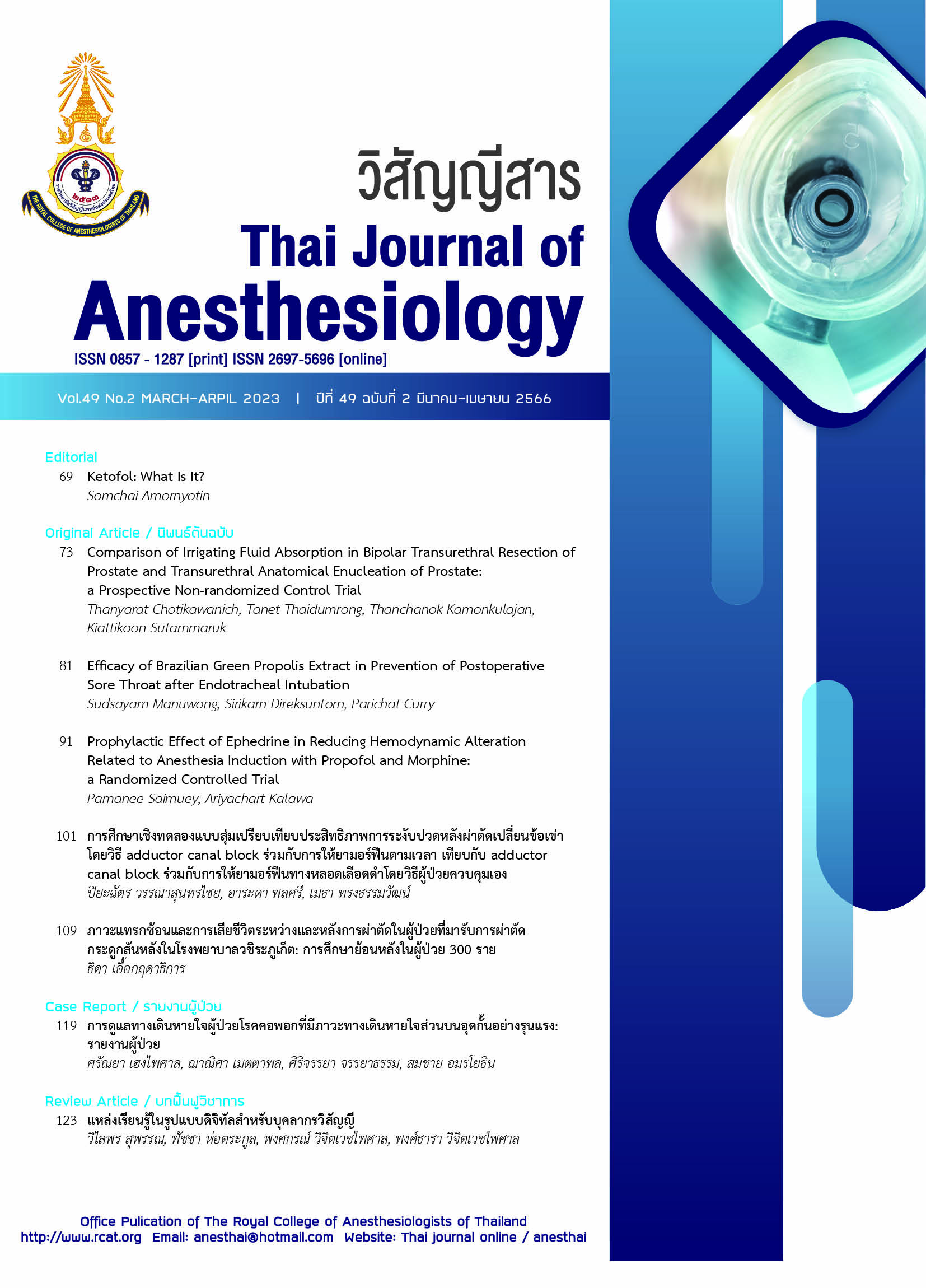Efficacy of Post Total Knee Arthroplasty Pain Control by Adductor Canal Block plus Morphine Around the Clock versus Adductor Canal Block plus Patient Control Analgesia Intravenous Morphine: a Randomized Controlled Trial
Main Article Content
Abstract
Background: Total knee arthroplasty (TKA) can produce moderate to severe postoperative pain. Adductor canal block (ADB) combine with patient control analgesia (PCA) has been accepted in many hospitals. However, the number of PCA machines are limited in many hospitals. Objective: To compare the efficacy of postoperative TKA pain control using ADB plus morphine around the clock versus ADB plus intravenous morphine by PCA. Methods: Prospective randomized control trial study, the participants undergoing TKA, the study group were assigned to the ADB plus morphine around the clock (n=30) and the control group were ADB plus PCA (n=30). Postoperative pain was assessed with verbal numerical rating scale (VNRS) every 6 hours in the first 24 hours. The side effect, dosage of morphine consumption and the patient satisfaction were also recorded. The data were analyzed using descriptive statistic, unpaired t test or Wilcoxon range sum test for the comparison of postoperative VNRS and other continuous variables. The Pearson chi square or Fisher exact test were used for the comparison of discrete variables. Results: Demographic variables were similar in both groups. There were no significant differences in postoperative VNRS scores, both at rest and on motion, at 6, 12, 18 and 24 hours between ADB plus morphine around the clock and ADB plus PCA groups. The first 24 hours morphine consumption in the ADB plus PCA was significantly higher than in the ADB plus morphine around the clock group (P=0.031). The side effects and patient satisfaction were not significantly different between the two groups. Conclusion: The efficacy of post TKA pain control from ADB plus morphine around the clock is comparable with ADB plus intravenous morphine by PCA. Therefore, it can be used in the resource limited hospital.
Article Details

This work is licensed under a Creative Commons Attribution-NonCommercial-NoDerivatives 4.0 International License.
References
Aso K, Izumi M, Sugimura N, et al. Additional benefit of local infiltration of analgesia to femoral nerve block in total knee arthroplasty: double-blind randomized control study. Knee Surg Sports Traumatol Arthrosc. 2019;27:2368-74.
Seo SS, Kim OG, Seo JH, Kim DH, Kim YG, Park BY. Comparison of the effect of continuous femoral nerve block and adductor canal block after primary total knee arthroplasty. Clin Orthop Surg. 2017;9:303-9.
Dimaculangan D, Chen JF, Borzio RB, Jauregui JJ, Rasquinha VJ, Maheshwari AV. Periarticular injection and continuous femoral nerve block versus continuous femoral nerve block alone on postoperative opioid consumption and pain control following total knee arthroplasty: randomized controlled trial. J Clin Orthop Trauma. 2019;10:81-6.
Li D, Ma GG. Analgesic efficacy and quadriceps strength of adductor canal block versus femoral nerve block following total knee arthroplasty. Knee Surg Sports Traumatol Arthrosc. 2016;24:2614-9.
Li JW, Ma YS, Xiao LK. Postoperative pain management in total knee arthroplasty. Orthop Surg. 2019;11:755-61.
McNicol ED, Ferguson MC, Hudcova J. Patient controlled opioid analgesia versus non-patient controlled opioid analgesia for postoperative pain. Cochrane Database Syst Rev. 2015;6:CD003348.
Fernandes MTP, Hernandes FB, de Almeida TN, Sobottka VP, Poli-Frederico RC, Fernandes KBP. Patient-controlled analgesia (PCA) in acute pain: pharmacological and clinical aspects. In: Maldonado C, ed., Pain relief-From analgesics to alternative therapies. IntechOpen, Croatia. 2017;p47-62.
Breivik H, Borchgrevink PC, Allen SM, et al. Assessment of pain. Br J Anaesth. 2008;101:17-24.
Haefeli M, Elfering A. Pain assessment. Eur Spine J. 2006;15:S17-24.
Neal JM, Woodward CM, Harrison TK. The American Society of Regional Anesthesia and Pain Medicine checklist for managing local anesthetic systemic toxicity: 2017 version. Reg Anesth Pain Med. 2018;43:150-3.
แคทรียา เทนสิทธิ์, เดือนเพ็ญ สิงหพรหมสาร. เปรียบเทียบวิธีการระงับปวดหลังผ่าตัดกระดูกสันหลังระหว่างการใช้เครื่องควบคุมความปวดด้วยตนเองและการฉีดยาแก้ปวดตามเวลา. วิสัญญีสาร. 2553;36:42-54.
Moucha CS, Weiser MC, Levin EJ. Current strategies in anesthesia and analgesia for total knee arthroplasty. J Am Acad Orthop Surg. 2016;24:60-73.
Korean Knee Society. Guidelines for the management of postoperative pain after total knee arthroplasty. Knee Surg Relat Res. 2012;24:201-7.
Dixit V, Fathima S, Walsh SM, et al. Effectiveness of continuous versus single injection femoral nerve block for total knee arthroplasty: a double blinded, randomized trial. Knee. 2018;25:623-30.
Chan EY, Fransen M, Parker DA, Assam PN, Chua N. Femoral nerve blocks for acute postoperative pain after knee replacement surgery. Cochrane Database Syst Rev. 2014;13:CD009941.
Walder B, Schafer M, Henzi I, Tramèr MR. Efficacy and safety of patient-controlled opioid analgesia for acute postoperative pain. A quantitative systematic review. Acta Anaesthesiol Scand. 2001;45:795-804.
Dias AS, Rinaldi T, Barbosa LG. The impact of patients controlled analgesia undergoing orthopedic surgery. Braz J Anesthesiol. 2016;66:265-71.
ณัฐรินทร์ ดิฐศิรพงศ์, ประวีณ ทับแสง. การศึกษาเปรียบเทียบประสิทธิภาพการระงับปวดด้วยตนเองทางหลอดเลือดดำ, การให้ยารงับปวดมอร์ฟีนทางช่องเหนือไขสันหลัง (อิพิดูรัล) และการให้ยาระงับปวดมอร์ฟีนทางหลอดลือดดำโดยให้ตามเวลาที่กำหนดในผู้ป่วยข้ารับการผ่าตัดนิ่วแบบเปิดในโรงพยาบาลมหาสารคาม. วารสารโรงพยาบาลมหาสารคาม. 2558;12:35-47.
Ferrante FM, Orav EJ, Rocco AG, Gallo J. A statistical model for pain in patient-controlled analgesia and conventional intramuscular opioid regimens. Anesth Analg. 1988;67:457-61.
Dahl JB, Daugaard JJ, Larsen HV, Mouridsen P, Nielsen TH, Kristoffersen E. Patient-controlled analgesia: a controlled trial. Acta Anaesthesiol Scand. 1987;31:744-7.
Bayer U, Basaran M, Atasoy N, Ayoglu H, Sade H, Altunkaya H. Comparison of satisfaction and pain relief between patients-controlled analgesia and interval analgesia after laparoscopic ovarian cystectomy. J Psychosom Obstet Gynaecol. 2008;29:139-45.
Morad AH, Winters BD, Yaster M, et al. Efficacy of intravenous patient-controlled analgesia after supratentorial intracranial surgery: a prospective randomized controlled trial. Clinical article. J Neurosurg. 2009;111:343-50.
Walson PD, Graves PS, Mortensen ME, Kern RA, Torch MA. Patient-controlled versus conventional analgesia for postsurgical pain relief in adolescents. Dev Pharmacol Ther.1992;19:32-9.
Hudcova J, McNicol E, Quah C, Lau J, Carr DB. Patient controlled opioid analgesia versus conventional opioid analgesia for postoperative pain. Cochrane Database Syst Rev. 2006;18:CD003348.
Forst J, Wolff S, Thamm P, Forst R. A randomized study of patient-controlled analgesia versus conventional pain therapy. Arch Orthop Trauma Surg. 1999;119:267-70.


